Methods of achieving Eternity with an aid of blockchain
Eternity is in love with the productions of time.-William Blake
The first widely known use case for blockchain is Bitcoin, where it is used to timestamp transactions. Even after 20 years pass, you can find the transaction exactly in the block where you left it. However, you don't have to use it only for triple entry accounting of money. Anybody can use such a trouble proof tool to save important messages and data. Our story is about Eternal accounting of data and events.
Many ways of storing information within a decentralized ecosystem are open to exploration. You can use several automated options that we outline in this text.
1. Cryptocurrencies that were made for information storage
There are specialized blockchains designed for data hosting. You can download the network client, top up the balance and pay for decentralized file storage or act as a service provider and earn money. In most cases, a client will pay for the service with a native cryptocurrency of the system of their choice. It is probably the simplest and cheapest method of storing information in such kind of systems. The most famous 'distributed cloud' projects are BTT, Siacoin, Filecoin, and Storj.1.1 BTT
It appears that BitTorrent Token (BTT) and BitTorrent network are separate things. The token was added to the uTorrent software updates pack back in 2019. BTT is a branded cryptocurrency that is running as a token on the TRON blockchain. Official Torrent client creators have added this token as a means of rewards for the users of their decentralized file-sharing ecosystem.In a network of anonymous file holders such as BitTorrent, there is no direct connection between financial context and data storage. Some people use third party clients to access the network, other ones won't update the official client for years. As a result, no rewards for many of the torrent file owners (aka peers). Torrent Peers appear and disappear in the network anytime they want. That's why if a file in the torrent network is too old, it probably has zero peers. So, BTT is a business-related system of user rewards, and it is working as a unique bonus card system for the uTorrent official client users. Almost no relation with Eternal data storage here.
https://www.bittorrent.com/btt/

1.2 SIACOIN
Another option is Siacoin, a project aimed at storing the files in a decentralized cloud. Such projects are a good option for a couple of reasons - a simple design, monetization model, unique features (like seed-based file recovery), and people are utilizing the network.Sia has the custom algo for dividing files into pieces before sending them to the peers that provide storage space. Each piece is addressed to a number of separate nodes across the planet. Also, the project is using Reed-Solomon erasure coding, which helps retrieve data while having only 10 out of 30 pieces. Magic of cryptography in action! Your file pieces are encrypted so that the peers won't read them as centralized data storage corporations do.
https://sia.tech

1.3 STORJ
The next option is Storj. It is an open-source app which is also a crypto wallet (just like Sia or Filecoin). Prepare a minimum of 550GB of available disk space, and a minimum of 2 TB available bandwidth per month. If you have a bad Internet connection, that's unacceptable. Keep your node online 24/7 and you'll get rewards in Storj by helping people to store their files in your living room. They have node operator requirements not acceptable by anyone.The method is somewhat a cloud hosting mixed with IPFS. It is more decentralized, yet not too distributed. Once node owner goes offline, there's nothing to stop them. Network balance relies on the inflow of newcomers, just like with the Torrent or Siacoin data storage model. And those newcomers need to learn a lot of tech related information before they can start supporting the network (that is a natural barrier to mass adoption of this technology).
https://storj.io
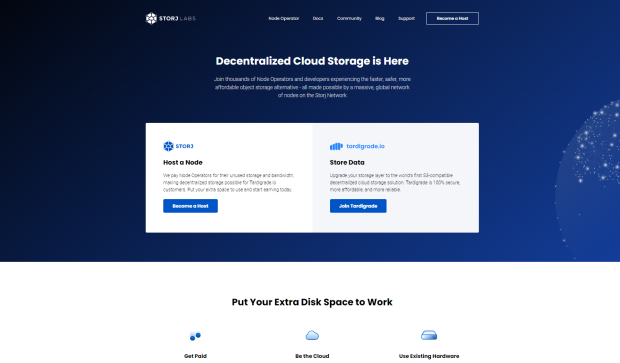
1.4 FILECOIN
Another example is Filecoin. This project is intended to be a distributed cooperative digital storage and data retrieval method. Filecoin is using a network of peers receiving payouts for data storage. The network users call them 'storage miners'. It is similar to Storj and Filecoin, but with technical differences. You will need to study hard the details of the node network system. The system is based on both proof-of-replication and proof-of-spacetime. If you don't have any idea on what's that, don't worry: most of the crypto users don't know either. Unfortunately, Windows OS is not yet supported.
https://filecoin.io

Above mentioned projects are cool in terms of having a decent user interface and a file storage technology. You have a vital choice of different data plans with gigabytes of free space waiting for you. However, there are certain downsides to making these projects a base for Eternal messages.
First, it's a small number of network nodes. Nobody knows if or when the network starts gaining traction.
Second, such coins suffer from a lack of support among 'crypto OGs' and general crypto users. The services work, yet sometimes they don't work. They already became an easy target for technical and social engineering hacks, miner revolts, etc. The scary factors create uncertainty among investors and users. And a culture of centralized development built around such projects (which is an issue in many cryptocurrency designs) makes it impossible to predict their long-term fate. And we seek Eternity, right?
Third, data storage in those networks is only possible when user pays for it on a regular basis (keeps enough coins on the wallet balance). As soon as the balance reaches zero, data gets erased. Even though the user may put enough coins to keep hosting his data for another century, taking into account an extremely volatile exchange rates for those currencies it doesn’t really feels like something eternal.
2. Saving the message to blockchain metadata
2.1 Write with ETHEREUM
In Ethereum, a separate field for data is available for any transaction sent to a contract. You can attach a large novel to the transaction and see it within a Transaction Data field on several online explorers, such as Cryptoid.info or Etherscan.io. Whenever a user has enough ETH on his account to pay for such a transaction, this data will be saved into the Ethereum blockchain. In other words, it is a 'pay once, read forever' scheme. We found it to be an extremely handy functionality. And we dare to make some data eternal, so please join the game.Our service made use of this possibility and created a special decentralized application that allows any person to write a sacred message into the blocks of Ethereum. Please, read our article “Making an Eternal Message with Note4Ever, Ethereum Blockchain and MetaMask” to obtain detailed instructions on how to do so. The huge upside here is that Ethereum network is very popular and works globally. You won't have to bother 'whether Ethereum network is online and working' after ten years pass. As long as you have a Web connection, it will deliver data. This is the magic of Ethereum, a base for smart contracts. Give it a free try using Note4Ever, Metamask and Kovan Testnet (Testnets don't use real coins, but test ones). Generally, in Ethereum Classic, TRON, BNB or EOS, people can write eternal data by sending it to smart contracts too. There are certain methods and interfaces helping you to read such messages. We will consider developing our decentralized applications for those networks as well.
https://etherscan.io/tx/0x9b2385d146576ea9ad94e4da2872ed260ed03874b86109dffe55e31cca230c9f
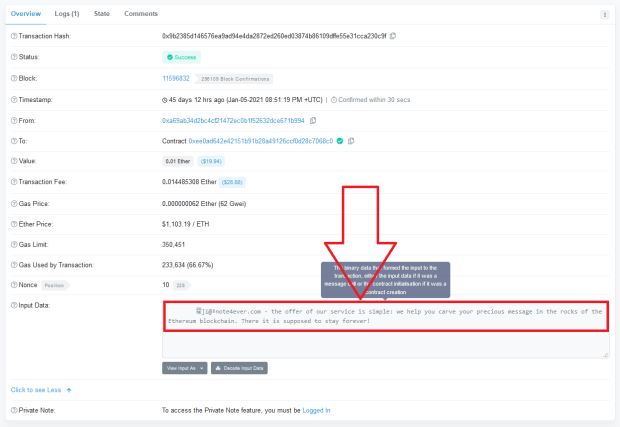

2.2 Write with BITCOIN
Another effective way to write an Eternal message is using Bitcoin's transaction metadata.Bitcoin is the most secured decentralized system, it is using hash power (network strength) to fight with a single point of failure hacks, such as the 51 percent attacks. It means that Bitcoin transactions and data are tightened by the network rules requiring the miners to prove their work with lots of computations. Also, Bitcoin has the biggest node network so far, it demonstrates growing user support. Thus, if you manage to save your message into the blockchain of Bitcoin, it is guaranteed to become immortal.
Writing to Bitcoin mainnet is a bit tricky. You are able to hide raw or encoded messages in some of the transaction data fields, such as Bitcoin's OP RETURN or Coinbase data fields.
2.2.1 OP RETURN
The OP RETURN field is the Opcode function that is working in the BTC network as of now, it allows for 40 arbitrary bytes to be used in transaction. Also, not more than one output with OP_RETURN can be included in it. These rules are very strict and will certainly limit your creative efforts.
https://blockchair.com/bitcoin/transaction/8bae12b5f4c088d940733dcd1455efc6a3a69cf9340e17a981286d3778615684
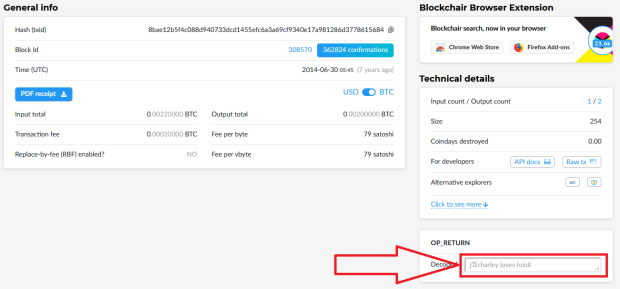
2.2.2 COINBASE
Coinbase reward is the network's award that is going to any miner who found a block, together with the transaction fees. Coinbase data is the small text that the crypto miners can attach to the mined blocks. Satoshi Nakamoto, the creator of Bitcoin, was the first person who wrote a message to a special BTC block called the Genesis block. Satoshi added a news headline to the first block of Bitcoin using the Coinbase data field. This way, Satoshi featured it in Eternity. The message reads: "The Times 03/Jan/2009 Chancellor on brink of second bailout for banks".
https://blockchair.com/bitcoin/block/0
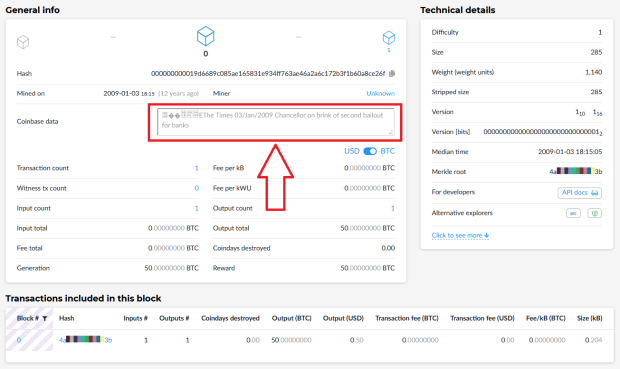
Please, read more information on Bitcoin's Genesis block here and here. Unfortunately, this method of storing messages isn’t available to majority of users. These days, only mining pools and very few hardware rich solo-miners are capable of finding the next bitcoin block and make their short text eternal.
Here at Note4Ever we took these challenges (limitations) seriously. We want to make it possible for every user to write his precious Message into the best cryptocurrency chain on the planet Earth. We found a number of solutions which will help you to overcome the imposed limitations on the maximum length of the message and the cost of its placement. These solutions are discussed in details below.
3. Encoding data in the addresses, instead of the transaction metadata
Sure, Bitcoin was meant to be a public ledger for wealth accounting. However, it is a tool for eternal data storage as well. So, we decided to make a maximum use of it.3.1 Address as a text message
The first option is to form the addresses in a way that the they will contain a piece of a desired text. The fact that you can grab that message directly during a chain exploring session is fantastic. You only have to learn how to browse addresses using websites like Blockchain.com, Btc.com, Blockcypher.com, Blockchair.com,, etc. However, there are some limitations - you cannot write/read certain symbols (O, 0, I, l); there's no way to add a space between words; addresses are short, plus they end with obligatory checksum symbols. This means you can only change the first 20-25 characters of each address. Thanks to the growing bitcoin price, such operations also drain your wallet funds. Using this same method, you can write messages to Litecoin, Dogecoin, Bitcoin Cash and many other bitcoin-like altcoins to save lots of cash on fees. In any of such cryptocurrencies, the message is limited to roughly 1000 of output addresses per transaction because the block size is limited (one to four Megabyte block every 10 minutes, in Bitcoin on average). You need technical skills to place the addresses in the correct order during the transaction creation. Not every crypto wallet can place the addresses in the desired order. Such a little puzzle is easy to solve by adding one satoshi to every next receiving address. This option is easy to use, yet not suited for large text delivery. In spite of named limitations, we find such method of making short messages eternal to be quite attractive and popular among mid-level crypto users.https://www.blockchain.com/btc/tx/57b749c0e8192d744c017ee34a6be0a6a2eba8e6a2c6f54df564ec9c569b0d41
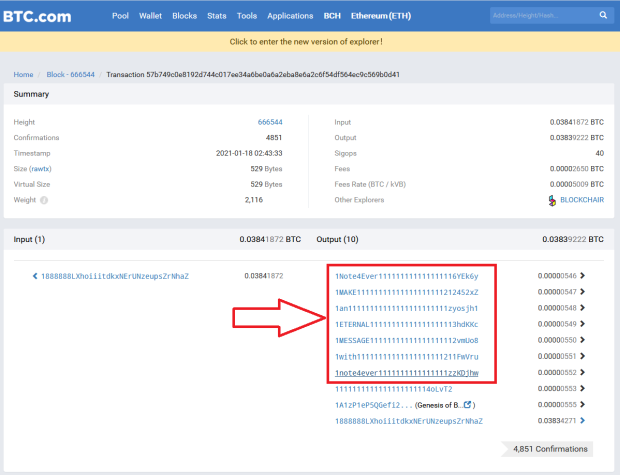
3.2 Address as a container
Second way of writing data to blockchains is by encoding a message in a series of addresses. Each Bitcoin Legacy address is made of 25 bytes that are encoded with base58 into a set of 34 characters. The first byte is a network byte, last 4 bytes are checksum, where the remaining 20 may be used for storing your data. So, you can store 200 bytes of text in a group of ten addresses, and a group of 100 addresses gives 2000 bytes of storage space. An advantage of this method is that you can store up to 19Kb of text within one transaction. Minus here is that you need to know how to encode/decode addresses with the message within. Different web services and scripts use different encoding methods. Theoretically, there are lots of secret messages currently living in Bitcoin and Ethereum chains. And the only thing separating them from insane publicity is that outsiders cannot read such messages without knowing the key, i.e. they have to know where and how to look for such kind of messages. At Note4Ever we made a special script that allows encoding and decoding messages using a list of addresses as a container. Check our article “Making an Eternal Message with Note4Ever, Bitcoin Blockchain and Electrum Wallet” to have a detailed instruction on how to do it with Bitcoin. Here's an example transaction:https://btc.com/8c7e5db7f1eb38ebacfa0d20b11e6d919b6664a903f3285330b108b46e520599


3.3 Transaction as a container
Third method for writing your data into Eternity is a bit more complicated. It works by encoding message directly into the raw transaction and broadcasting it. Bright example - Digital Anarchist & Bitcoiner – Gr0kchain, who has encoded a complete Bitcoin White Paper by Satoshi Nakamoto with the following Bitcoin TX:https://www.blockchain.com/btc/tx/54e48e5f5c656b26c3bca14a8c95aa583d07ebe84dde3b7dd4a78f4e4186e713
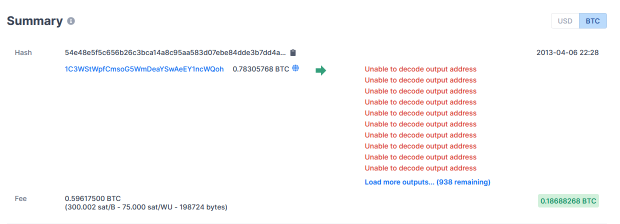
So far it is the cheapest method of storing more data within one transaction, because it doesn’t waste bytes on checksums and values.
But it also requires using additional converters, plus knowing how to broadcast such a transaction, that might not be accepted by a network. Worth noting that your transaction won’t look like a set of innocent addresses in block-explorers, but as a list of “Unable to decode output addresses”.
Conclusion
Note4Ever offers simplified methods of writing Eternal Messages to a set of most popular blockchains. Easy to use tools are at your service. Some may think the offer is too expensive. However, consider the possibility to send yourself (or to the future generations) a note and be sure that it will be accessible and intact in 50 years, what do you feel? Imagine the Eternity of the seas, the forests, the mountains, or the whole Earth. Not flattering: a skill of writing Eternal Messages makes you a demi-god, a tech genius among locals, and a creator of immortal something.
